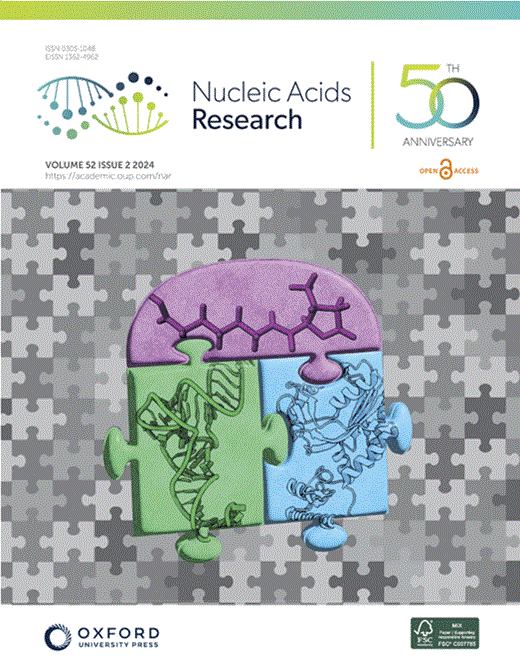Comprehensive mutational analysis of the sequence-function relationship within a viral internal ribosome entry site.
IF 16.6
2区 生物学
Q1 BIOCHEMISTRY & MOLECULAR BIOLOGY
引用次数: 0
Abstract
The cricket paralysis virus (CrPV) intergenic region internal ribosome entry site (IRES) binds to the ribosome without the need for any initiation factors. Their length, simple mechanism, and ability to function in diverse cell-free systems make CrPV-like IRESs useful tools to study the mechanism of translation and to express proteins. We report the use of a RelE-based next-generation sequencing method, termed SMARTI (sequencing-based mutational analysis of RNA translation initiation), to quantitatively determine the function of over 81 000 single and double mutants of CrPV IRES. The result is a comprehensive mutational database that serves as a consensus sequence-like analysis of IRES function. We have given particular attention to the sequence requirements within the three pseudoknots of the IRES element. The data indicate that each pseudoknot contains positions that are modifiable and mutation may even enhance IRES function through pseudotranslocation. CrPV IRES must balance being stable and dynamic as it forms the structure and ribosomal contacts required for translation initiation. Helical regions, especially in the transfer RNA-mimicking domain, are areas where flexibility may be especially beneficial. Moreover, we demonstrated that this high-throughput method is compatible with eukaryotic extract, providing an avenue for studying diverse eukaryotic RNA elements and for engineering sequences for protein expression.病毒内核糖体进入位点序列-功能关系的综合突变分析。
蟋蟀麻痹病毒(CrPV)基因间区核糖体内进入位点(IRES)无需任何起始因子即可与核糖体结合。它们的长度、简单的机制和在多种无细胞系统中发挥作用的能力使CrPV-like IRESs成为研究翻译机制和表达蛋白质的有用工具。我们报告了使用基于rel的下一代测序方法,称为SMARTI(基于测序的RNA翻译起始突变分析),定量确定超过81000个CrPV IRES单突变和双突变体的功能。结果是一个全面的突变数据库,作为IRES功能的共识序列分析。我们特别注意了IRES元素的三个假结内的序列要求。数据表明,每个假结包含可修改的位置,突变甚至可以通过假易位增强IRES功能。CrPV IRES在形成翻译起始所需的结构和核糖体接触时必须平衡稳定和动态。螺旋区域,特别是在转移rna模拟区域,是灵活性可能特别有益的区域。此外,我们证明了这种高通量方法与真核提取物兼容,为研究各种真核RNA元件和蛋白质表达的工程序列提供了途径。
本文章由计算机程序翻译,如有差异,请以英文原文为准。
求助全文
约1分钟内获得全文
求助全文
来源期刊

Nucleic Acids Research
生物-生化与分子生物学
CiteScore
27.10
自引率
4.70%
发文量
1057
审稿时长
2 months
期刊介绍:
Nucleic Acids Research (NAR) is a scientific journal that publishes research on various aspects of nucleic acids and proteins involved in nucleic acid metabolism and interactions. It covers areas such as chemistry and synthetic biology, computational biology, gene regulation, chromatin and epigenetics, genome integrity, repair and replication, genomics, molecular biology, nucleic acid enzymes, RNA, and structural biology. The journal also includes a Survey and Summary section for brief reviews. Additionally, each year, the first issue is dedicated to biological databases, and an issue in July focuses on web-based software resources for the biological community. Nucleic Acids Research is indexed by several services including Abstracts on Hygiene and Communicable Diseases, Animal Breeding Abstracts, Agricultural Engineering Abstracts, Agbiotech News and Information, BIOSIS Previews, CAB Abstracts, and EMBASE.
 求助内容:
求助内容: 应助结果提醒方式:
应助结果提醒方式:


